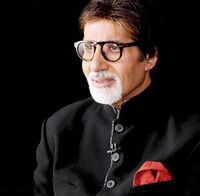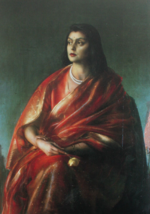Monarchy of Rajyaghar: Difference between revisions
| Line 46: | Line 46: | ||
===Religious Role=== | ===Religious Role=== | ||
== | ==List of Monarchs== | ||
{|class="wikitable" | {|class="wikitable" | ||
| Line 226: | Line 60: | ||
|<center>[[Krishan VI]] | |<center>[[Krishan VI]] | ||
|[[File:Ganga Singh c1930.jpg|150px|frameless|center]] | |[[File:Ganga Singh c1930.jpg|150px|frameless|center]] | ||
|<center>3rd November 1877 - 7th September | |<center>3rd November 1877 - 7th September 1961<br>(Aged 86) | ||
|<center> | |<center>17th October 1946 | ||
|<center>7th September 1961 | |<center>7th September 1961 | ||
|<center> | |<center>15 years | ||
|<center>His Majesty, Krishan III, Maharaja of Rajyaghar | |<center>His Majesty, Krishan III, Maharaja of Rajyaghar<br>Lord Protector of Bishnupur | ||
---- | ---- | ||
''"Krishan | ''"Mahatma Krishan, Bapu ke Raashtr"'' <sup>1</sup><br><small>Krishan the Venerable, Father of the Nation</small> | ||
|- | |- | ||
|<center>[[Rajaram V]] | |<center>[[Rajaram V]] | ||
| Line 240: | Line 74: | ||
|<center>23rd February 1964 | |<center>23rd February 1964 | ||
|<center>>3 years | |<center>>3 years | ||
|<center>His Majesty, Rajaram V, Maharaja of Rajyaghar<br> | |<center>His Majesty, Rajaram V, Maharaja of Rajyaghar<br>Sarvoch Rashak of Bishnupur | ||
|- | |- | ||
|<center>[[Shakti III]] | |<center>[[Shakti III]] | ||
| Line 248: | Line 82: | ||
|<center>10th April 1984 | |<center>10th April 1984 | ||
|<center>17 years | |<center>17 years | ||
|<center>Her Majesty, Shakti III, Maharani of Rajyaghar<br> | |<center>Her Majesty, Shakti III, Maharani of Rajyaghar<br>Sarvoch Rashak of Bishnupur | ||
|- | |- | ||
|<center>[[Krishan VII]] | |<center>[[Krishan VII]] | ||
| Line 256: | Line 90: | ||
|<center>Incumbent | |<center>Incumbent | ||
|<center>''36 years'' | |<center>''36 years'' | ||
|<center>His Majesty, Krishan VII, Maharaja of Rajyaghar<br> | |<center>His Majesty, Krishan VII, Maharaja of Rajyaghar<br>Sarvoch Rashak of Bishnupur | ||
|- | |- | ||
|} | |} | ||
<small> | <small>1 = Title given posthumously</small><br> | ||
==Succession== | ==Succession== | ||
Revision as of 12:49, 28 March 2021
| Maharaja of Rajyaghar | |
|---|---|
 | |
| Incumbent | |
 | |
| Incumbent since April 10th 1984 | |
| Details | |
| Style | His Majesty |
| Heir apparent | Shivaji, Prince of Sanyukt |
| First monarch | Krishan III |
| Formation | 1935 |
| Residence | Royal Palace of Kinadica, Samudra Palace |
| Appointer | Hereditary |
The Monarchy of the Kingdom of Rajyaghar, commonly referred to as the Rajyani Monarchy, is the constitutional monarchy of the Kingdom of Rajyaghar. The current monarch is Maharaja Krishan VII, who ascended the throne in 1984. The heir apparent to the throne, styled as the Prince of Sanyukt, is Prince Shivaji who assumed this position upon the ascension of his father Krishan III to the throne.
The Maharaja, or Maharani when the monarch is female, is aided in their ceremonial and diplomatic duties by their immediate family. The Maharaja is also the head of the armed forces as the Commander in Chief as well as the Government. However, the executive functions of the Government are carried out by the Prime Minister and their Cabinet who are all appointed by the Maharaja following the procedures laid out in the constitution. As a result, the Armed Forces are formally called "His Majesty's Armed Forces" and the Government is "His Majesty's Government".
The Monarchy of Rajyaghar is considered to be one of the oldest monarchies in the world with the origins of the Rajyani Monarchy date back to 430 CE when the Rajana Dynasty was founded. When Kismat was looted by the Mirza Sultante in 800 CE, the only surviving member of the Rajana Dynasty was Prince Prashant, aged 7, who was evacuated from the city by one of the Rajana Generals; Sunder Sirasikar. Sirasikar would flee with the young Prince to Kinadica where he would lead what remained of the Rajana Dynasty's forces on behalf of the young Prince. In 815, after trying to unify the splintering Rajana Dynasty, the now King Prashant created the Sanyukti Confederacy to rule over the territories he could control whilst the rest of the Dynasty was split by its warring generals. The Rajana Royal Family survived through King Prashant and his successors in the Sanyukti Confederacy for over a thousand years as it transformed into the Sanyukti Empire. When, the Sanyukti Empire fell to XX in the 1840s, the Rajana Royal Family continued on as Princes of the Colonial State of Sanyukt within the XX Colony of the Rajyani Territories until in the 1940s, the Sanyukti Princes were called on by Rajyani leaders to lead the newly independent Rajyaghar as Maharajas.
In modern Rajyaghar, the Monarchy plays an important functional role in the government and armed forces, as set out by the Constitution as well as through convention, precedent and tradition. The Monarchy also plays an important role in the tulyatan faith in Rajyaghar, despite the faith being considered an 'unorganised religion'. The Maharaja is tasked with appointing, at their discretion, the High Priest of Bishnupur who is the most senior tulyatan priest in the country. This has been a duty performed by the Head of the Rajana Dynasty since 1706.
Duties and Responsibilities
Executive Role
Legislative Role
Judicial Role
Military Role
Religious Role
List of Monarchs
| Name | Portrait | Life span | Reign start | Reign end | Length of Reign | Official Titles |
|---|---|---|---|---|---|---|
(Aged 86) |
Lord Protector of Bishnupur "Mahatma Krishan, Bapu ke Raashtr" 1 | |||||
(Aged 60) |
Sarvoch Rashak of Bishnupur | |||||
(Aged 78) |
Sarvoch Rashak of Bishnupur | |||||
(Age 76) |
Sarvoch Rashak of Bishnupur |
1 = Title given posthumously
Succession
Succession to the throne is strictly regualated by the Constitution of the Kingdom of Rajyaghar and through various subsequent Acts of Parliament. The Constitution lays out that the only male descendants of Krishan VI may ascend to the throne of Rajyaghar. The first Act of Parliament to add restrictions on successsion to the throne was in 1942 when the Government introduced the "Succession Act of 1942" in which it barred non-tulyatans from ascending to the throne. In 1956, Krishan VI asked the Shahee Sansad to amend the Constitution to allow the ascension of female descendants to the throne. The Amendment was passed by the Shahee Sansad and signed into effect as a Royal Decree in 1957, bypassing a national referendum.
Upon the death of the Monarch the heir to the throne immediately becomes the new Monarch, hence the phrase "The Maharaja is Dead! Long live the Maharaja!". The ascenscion of the new monarch is formally announced by the Sachiv (Secretary) of the Ashtapradhan (Council of Eight) to the Ascension Council which meets at the Royal Palace of Kinadica. In Kinadica, the Mayor announces the death of the monarch and ascension of the new monarch outside the main gates to Samudra Palace.
Upon their ascension, the new monarch is required to sign and take several oaths: the Ascension Declaration stating their willingness to ascend to the throne; an Oath of Dedication to the Constitution reaffirming their duty to protect the principles of the Constitution; and an oath that they will "maintain and preserve" the tulyatan faith as well as the "culture and society of Rajyaghar". As the Constitution derives its power from the Monarch, the new monarch does not swear an oath of allegiance to the constitution but rather swears an oath that they will defend the basic principles and spirit of the Constitution. In Rajyaghar, no oath of allegiance to the constitution is sworn, all oaths of office and allegiance are to the Monarch as they give the Constitution power.
Upon the death of a monarch, there is a period of mourning of 11 days with the cremation of the former monarch occuring on the 11th day. The cremation takes place at the Memorial Arch on the Rajpath on Government Hill. The deceased monarch is laid on a marble plinth under the roof of the Arch between the four columns. The new monarch will then light the plinth from the gap between the two north facing columns of Memorial Arch. In 2010, Memorial Arch was rennovated to house hundreds of discreet and small extractor fans so that the ashes can be collected. This was in line with Maharaja Krishan VII's wishes so that he could be cremated at Memorial Arch but then his ashes be spread over the Naratha River.





